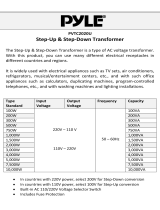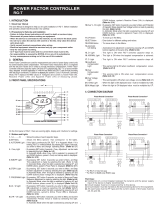
The trip value recorder information is an integrated part of the
disturbance record (Comtrade file).
Disturbance recorder DRPRDRE
The Disturbance recorder function supplies fast, complete and
reliable information about disturbances in the power system. It
facilitates understanding system behavior and related primary
and secondary equipment during and after a disturbance.
Recorded information is used for different purposes in the short
perspective (for example corrective actions) and long
perspective (for example functional analysis).
The Disturbance recorder acquires sampled data from selected
analog- and binary signals connected to the Disturbance report
function (maximum 40 analog and 96 binary signals). The binary
signals available are the same as for the event recorder function.
The function is characterized by great flexibility and is not
dependent on the operation of protection functions. It can
record disturbances not detected by protection functions. Up to
ten seconds of data before the trigger instant can be saved in
the disturbance file.
The disturbance recorder information for up to 100
disturbances are saved in the IED and the local HMI is used to
view the list of recordings.
Event function
When using a Substation Automation system with LON or SPA
communication, time-tagged events can be sent at change or
cyclically from the IED to the station level. These events are
created from any available signal in the IED that is connected to
the Event function (EVENT). The event function block is used for
remote communication.
Analog and double indication values are also transferred
through EVENT function.
IEC61850 generic communication I/O function SPGGIO
IEC61850 generic communication I/O functions (SPGGIO) is
used to send one single logical signal to other systems or
equipment in the substation.
IEC61850 generic communication I/O functions MVGGIO
IEC61850 generic communication I/O functions (MVGGIO)
function is used to send the instantaneous value of an analog
signal to other systems or equipment in the substation. It can
also be used inside the same IED, to attach a RANGE aspect to
an analog value and to permit measurement supervision on that
value.
Measured value expander block RANGE_XP
The current and voltage measurements functions (CVMMXN,
CMMXU, VMMXU and VNMMXU), current and voltage sequence
measurement functions (CMSQI and VMSQI) and IEC 61850
generic communication I/O functions (MVGGIO) are provided
with measurement supervision functionality. All measured
values can be supervised with four settable limits: low-low limit,
low limit, high limit and high-high limit. The measure value
expander block (RANGE_XP) has been introduced to enable
translating the integer output signal from the measuring
functions to 5 binary signals: below low-low limit, below low
limit, normal, above high-high limit or above high limit. The
output signals can be used as conditions in the configurable
logic or for alarming purpose.
12. Metering
Pulse counter logic PCGGIO
Pulse counter (PCGGIO) function counts externally generated
binary pulses, for instance pulses coming from an external
energy meter, for calculation of energy consumption values. The
pulses are captured by the binary input module and then read
by the function. A scaled service value is available over the
station bus. The special Binary input module with enhanced
pulse counting capabilities must be ordered to achieve this
functionality.
Function for energy calculation and demand handling ETPMMTR
Outputs from the Measurements (CVMMXN) function can be
used to calculate energy consumption. Active as well as
reactive values are calculated in import and export direction.
Values can be read or generated as pulses. Maximum demand
power values are also calculated by the function.
13. Basic IED functions
Time synchronization
The time synchronization source selector is used to select a
common source of absolute time for the IED when it is a part of
a protection system. This makes it possible to compare event
and disturbance data between all IEDs in a station automation
system.
Only GPS and IRIG-B time synchronization sources are
acceptable for phasor measurement from the accuracy point of
view, and RES670 supports both.
14. Human machine interface
Human machine interface
The local human machine interface is available in a medium
sized model. Up to 12 single line diagram pages can be
defined, depending on the product capability.
The local HMI is divided into zones with different functionality.
Phasor measurement unit RES670 ANSI
1MRK511254-BUS B
Customized
Product version: 1.2
14 ABB





















